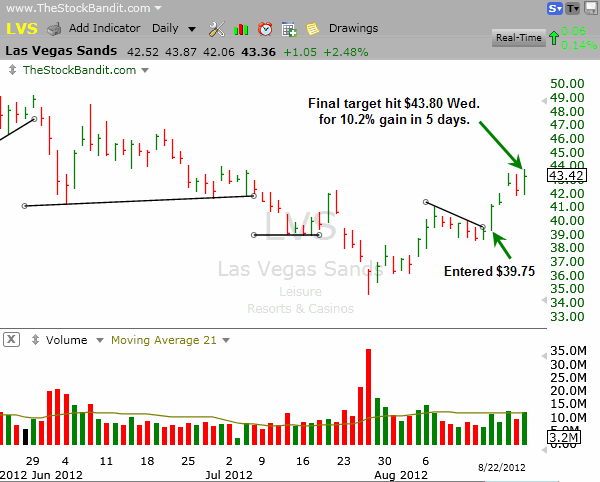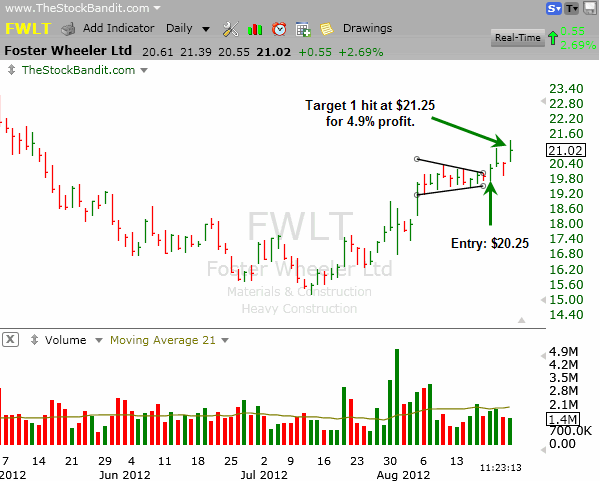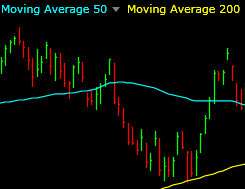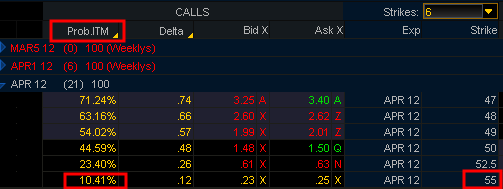 All Entries in the "Trading Tips" Category
All Entries in the "Trading Tips" Category
DVD Promo
November 30, 2012 at 1:04 pm
Christmas is coming, so here’s a gift any trader will like: half price seminar DVD’s.
If you didn’t catch me live this year in TX, NY, GA, CO, PA, NV or you won’t be in NC in two weeks (details will be coming on that shortly), you can learn what I taught for less than the price of a Texas SUV tank of gas!
These are the video recordings from a Denver seminar with about two hundred traders in the room, so there were some excellent questions asked as well.
Details and links for each are below. Shipping is free, so how can you beat it?
Formulating Your Trading Plan DVD
– How to adapt to changing markets
– Integrate your personality in your trading approach
– The numbers game of success in trading
+ Watch me read charts on the fly and sharpen your technical skills
Locating Trades & Evaluating Risk DVD
– Narrow down a watchlist into actionable ideas
– Decide if a move is imminent
– Become more decisive and limit losses
+ Watch me read charts on the fly and sharpen your technical skills
2-DVD Bundle
– Both of the dvd’s listed above for a combined discounted price
Before the bowl games begin and as your preparations for 2013 get underway, these will help you.
Trade Like a Bandit!
Jeff White
Subscribe to our Stock Pick Service to get our trades.
Trade Multiple Timeframes
August 23, 2012 at 11:42 am
This market has definitely favored the bulls since the June low. During that time, the S&P 500 has risen more than 11%, which isn’t bad at all in just 2 1/2 months. Every single dip has been bought, and those who have been stubborn enough to attempt to short sell pretty much anything for a timeframe longer than a quick scalp have faced a stiff headwind.
The market’s been strong – you just can’t deny it. The real money has been made on the long side, and there have been multiple timeframes which have been paying off nicely. We’ve seen days with bursts of strength for the intraday player, as well as multi-day and multi-week advances which have favored the swing trader.
This idea of trading across multiple timeframes is something I put a great deal of emphasis on, and lately that’s been one great way to diversify as a trader. That’s why it’s such a big element of what we teach.
Bread, Butter, and Gravy
The swing trades shared in our stock pick service are what we tend to focus on most – they’re our bread and butter. Generally, we hold them for a few days up to a couple of weeks. They provide larger moves but sometimes take a little more time to develop. We like to buy stocks coming out of defined chart patterns like bull flags or triangle patterns, and it works to our advantage.
For example, here are two setups which took a few days to make their moves, but which provided us with some quick profits.
One is LVS, which we entered at $39.75 as it cleared the descending trend line on 8/16 to begin a new leg higher. 5 sessions later, we booked a 10.2% profit (Wednesday).

Another is FWLT, which is an open position which we’ve already booked partial profits in. A move up through $20.25 was our trigger price on Monday, and earlier today (just 3 days later) the stock hit Target 1 for a quick 4.9% profit, allowing us to lighten and tighten.

And yes, we take losses too! However, we keep them small and admit defeat quickly when the market proves we’re wrong. That’s the key to surviving as a trader.
Grabbing the quicker day trade types of moves also gives us added market exposure while we’re waiting for the swing trades to develop. The profits from these trades are the gravy. Some last only minutes, but they can add considerably to the bottom line. These candidates are also based on the daily charts, but we just look to grab the initial moves in them of 2-4% typically.
Trading multiple timeframes is a nice way to diversify with your trading, especially right now when the market keeps edging higher. If you know how to catch the initial move when a stock breaks out, you can build up some quick profits while your other trades work on a different timeframe.
There’s nothing better than having your money working for you in the short-term AND in the intermediate-term as a trader! Always seek to uncover more opportunities on multiple timeframes, they’re out there right now. Or pay us to find them for you.
Jeff White
Get our free newsletter to keep up!
Why Your Option Trades Fail
March 30, 2012 at 8:41 am
Frequently traders will tell me instead of trading the common, that they’re eyeing the options instead. The idea is that they can ‘control the stock’ at a much lower price, which is correct, but it’s not as simple as they expect.
For example, with XYZ trading at $50, the $55 call might look cheap by comparison at $0.25, and many will go this route of buying a ‘cheap’ call instead of the shares. That isn’t much, but with only about a 10% chance of finishing in the money by expiration, the odds certainly aren’t favorable. Then consider the fact that to turn a profit, the stock has to move even higher ($55 + $0.25 paid for the call), and the likelihood of turning a profit diminishes even further.
Whether it’s options or common you’re trading, you never want to be in a position where you NEED the stock to make a sizeable move to just get your money back.
So the next time you’re considering buying an option instead of the stock, go deep in the money and consider paying what might look to be a more expensive price. The odds are more favorable, and you’re not putting yourself in such a needy position from the outset of the trade.
Trade Like a Bandit!
Jeff White
Producer of The Bandit Broadcast
Get our free newsletter to keep up!
Follow @TheStockBandit
Market Makers, Specialists, and Stops
October 28, 2011 at 9:40 am
A subscriber recently asked me:
“Do you believe market makers and specialists really gun for the orders that are on the books that are only a few hundred shares, or do they only search out bigger size?”
Here’s my response:
 My take on market makers and specialists is that they just want volume, all day, as they’re selling on the offer and buying on the bid. A few hundred shares here throughout the day add up to a lot. Stocks will naturally gravitate toward key areas of support and resistance, so if they just get close then it’s not that difficult for market makers to ‘spook’ prices a little further and run some stops.
My take on market makers and specialists is that they just want volume, all day, as they’re selling on the offer and buying on the bid. A few hundred shares here throughout the day add up to a lot. Stocks will naturally gravitate toward key areas of support and resistance, so if they just get close then it’s not that difficult for market makers to ‘spook’ prices a little further and run some stops.
Suppose there’s resistance just a few cents away, they know buy stops reside beyond that level. Flashing a big bid will have shorts quickly covering based upon the quote (which is real by the way), and buyers step in front of it in hopes of catching a run. They can then flip that large order to the ask and it spooks everyone to sell, taking the stock right back down to where it was.
You can see how doing that throughout the day adds to the back-and-forth range-bound type of price action which churns the accounts of retail traders and leaves the stock not necessarily making any big headway.
Also, do not discount the presence of programs doing this exact same thing. If supercomputers can automate the process via algo’s, all the better for the smart money to spook the retail traders out of positions on a regular basis. Head-fake moves which last only long enough to inflict enough pain to prompt an exit is all it takes, so it need not be a lasting move to catch the small trader off guard and separate him from a dime here or a quarter there.
One last thing…
On a trend day when market makers are shorting into strength (selling on the offer during an uptrend ), if they didn’t have a lot of inventory to dump, then they’re getting shorter the higher we go. They will hedge via futures (ES or NQ) or through options. Those derivatives have a huge impact on how the market moves, yet few traders really recognize that.
So when people watch call buying activity or put buying activity in the options, they think they know that someone big is betting on a rise or fall in the shares, but the fact is nobody knows if it’s that simple or if it’s part of a more complicated hedge for a market-neutral position.
It gets cloudy, but there’s my take on market makers and specialists. What’s your opinion?
Trade Like a Bandit!
Jeff White
Producer of The Bandit Broadcast
Follow TheStockBandit on Twitter or get our free newsletter to keep up!
Questioning the 50-day & 200-day MA’s
October 25, 2011 at 6:50 am
 My recent post on Indicatoritis discussed how some traders rely on indicators incorrectly.
My recent post on Indicatoritis discussed how some traders rely on indicators incorrectly.
I believe that still holds true, but I was questioned about some common moving averages on the heels of that post.
So in this video, I want to discuss moving averages, and more specifically, two moving averages which are commonly accepted by traders as important: the 50-day and the 200-day moving averages.
We’ll look at some big-name stocks and let the charts speak for themselves on whether it’s appropriate or not to leave these MA’s on the chart all the time.
Be sure to view in HD (720P) and full-screen mode for best quality in the video.
Trade Like a Bandit!
Jeff White
Producer of The Bandit Broadcast
Follow TheStockBandit on Twitter or get our free newsletter to keep up!
Day Trading Gaps
October 10, 2011 at 4:56 pm
Day traders love to fade gaps, but it’s not always the right thing to do. In this video, I’ll point out some key traits of big gaps to watch out for when deciding on initiating gap-fill trades.
Day trading gaps can be quite lucrative, particularly when it happens early in the session. However, there’s a flip side to it which must be considered – and it costs many traders money to ignore the warnings.
Check out the video for more on this topic, and be sure you’re on the email list so you’re always notified of new updates like this one.
Be sure to view in HD (720P) and full-screen mode for best quality in the video.
Trade Like a Bandit!
Jeff White
Producer of The Bandit Broadcast
Follow TheStockBandit on Twitter or get our free newsletter to keep up!
The Simplest Way to Trade
September 22, 2011 at 9:19 am
 When it comes to trading, complicated does not equate to better. So with that said, here’s a quick checklist you can use to keep your trading simple.
When it comes to trading, complicated does not equate to better. So with that said, here’s a quick checklist you can use to keep your trading simple.
Keep a core portfolio of positions you like.
Learn to locate new trades, identify patterns, and employ the best strategy given the conditions.
If the pattern confirms, enter the trade.
If the pattern fails, exit the trade.
If your target is met, reduce position (if momentum is still present) or exit completely.
Trading might not ever be EASY, but you can make it simple.
Trade Like a Bandit!
Jeff White
Producer of The Bandit Broadcast
Follow TheStockBandit on Twitter or get our free newsletter to keep up!







